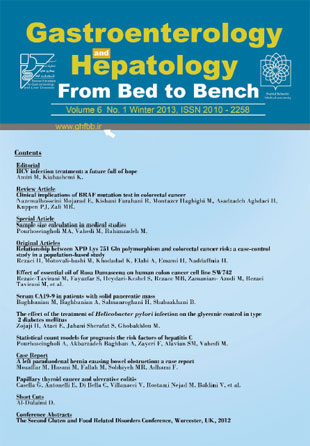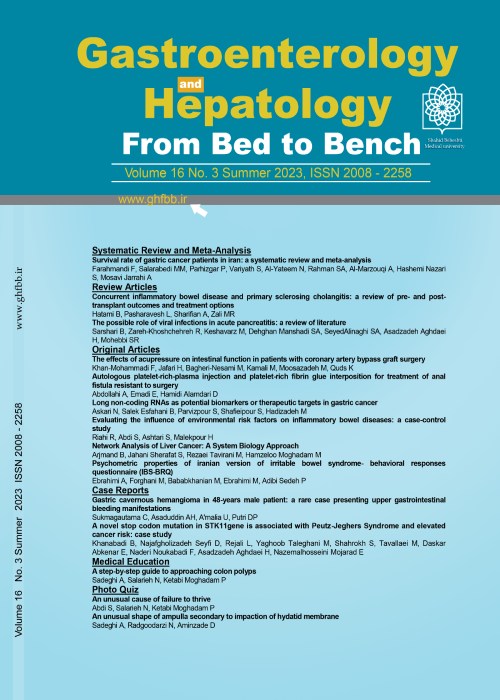فهرست مطالب

Gastroenterology and Hepatology From Bed to Bench Journal
Volume:6 Issue: 1, Winter 2013
- تاریخ انتشار: 1391/10/26
- تعداد عناوین: 12
-
-
Page 6Knowledge about the clinical significance of V-Raf Murine Sarcoma Viral Oncogene Homolog B1 (BRAF) mutations in colorectal cancer (CRC) is growing. BRAF encodes a protein kinase involved with intracellular signaling and cell division. The gene product is a downstream effector of Kirsten Ras 1(KRAS) within the RAS/RAF/MAPK cellular signaling pathway. Evidence suggests that BRAF mutations, like KRAS mutations, result in uncontrolled, non–growth factor-dependent cellular proliferation. Similar to the rationale that KRAS mutation precludes effective treatment with anti-EGFR drugs. Recently, BRAF mutation testing has been introduced into routine clinical laboratories because its significance has become clearer in terms of effect on pathogenesis of CRC, utility in differentiating sporadic CRC from Lynch syndrome (LS), prognosis, and potential for predicting patient outcome in response to targeted drug therapy. In this review we describe the impact of BRAF mutations for these aspects.Keywords: Colorectal Cancer, BRAF mutation, Prognosis value
-
Page 14Optimum sample size is an essential component of any research. The main purpose of the sample size calculation is to determine the enough number of units needed to detect the unknown clinical parameters or the treatment effects or the association after data gathering. It is not uncommon for studies to be underpowered and failing to detect the existed treatment effects due to inadequate sample size. In this paper, we explain briefly the basic principles of sample size calculations in medical studies.Keywords: Sample Size, Medical Studies
-
Page 18This study has examined the relationship between the XPD Lys 751 Gln polymorphism and colorectal cancer in 88 patients and their 88 age and sex-matched controls. Genomic DNA from peripheral whole blood was extracted using standard method to determine the genotype of subjects with RFLP-PCR analysis. Although this study shows cancer patients harbor more heterozygous genotype (XPD Lys 751 Gln) (OR=1.33, CI: 0.679-2.620 and less wild genotype (Lys751 Lys) compare to control group. However, it is not statistically significant (P = 0.406). Furthermore, colorectal cancer was less common in individuals with recessive homozygous genotype (OR=0.097, CI: 0.032-0.297; P= 00.000). Notably, in our study colorectal cancer was more frequent in male gender, elder people compared younger people and individuals with positive colorectal cancer in their first relatives (OR=4.5; CI= 2.010-10.044, P=0.000).Keywords: Colorectal cancer, Nucleotide excision repair, XPD gene, polymorphism
-
Page 25AimIn this study, the effect of the essential oil of Rosa damascena on human colon cancer cell line (SW742) and human fibroblast cells has been reported.BackgroundColon cancer is the second lethal disease after lung cancer. Owing to the existence of many side effects and problems related to common treatments such as surgery, chemotherapy and radiotherapy, better substitution is highly needed. Herbal medicine has been shown promising against different types of cancers recently; usage of their essential oils as drug contributes to a major part of traditional medicine. Patients andMethodsThe essential oil is provided by distillation method and its effects on SW742 cell line and fibroblast cells have been investigated. The cells were cultured and different volumes of essential oil were induced to the cells. After 48h incubation, cell survival was studied with MTT assay method. Using the statistical analysis, the findings were evaluated and reported.ResultsOne side of the present study shows that soluble part of essential oil can possibly stimulates cell growth in high volumes and the other side outlines the growth reducing properties of the evaporation part of the essential oil.ConclusionAnalytical data provide considerable information about pharmaceutical properties of the plant. It can be considered for discovery of drugs relating to cancer therapy and tissue engineering purposes.
-
Page 32AimThis study evaluated the results and efficacy of serum CA 19-9 in determining the nature of a pancreatic solid mass in patients referred for investigation of possible malignancy.BackgroundA wide variety of tumor markers have been proposed for pancreatic cancer but currently the only one with any practical usefulness for diagnosis, prognosis, and monitoring of treatment is “CA 19-9”. Patients andMethodsThis present study is a single center 2 year descriptive, prospective and case series studying patients with a pancreatic solid mass.ResultsSerum CA 19-9 was checked in 159 patients. The majority of patients were male (68%) and 81% had mass in the head of pancreas. Pathologic assessment revealed 131 adenocarcinomas (82%), 10 other malignancies (6%), 7 benign lesion (4%) and was non-diagnostic in 11 cases (7%). Mean level of this tumor marker in patients with adenocarcinoma, non-adenocarcinoma malignancy, benign and non-diagnostic pathology was 1094, 1004, 120, 259 U/ML respectively. With regarding 58 U/ML as a cutoff point; sensitivity, specificity, positive predictive value, negative predictive value and accuracy of this tumor marker for diagnosing the adenocarcinoma were 85%, 67%, 88%, 60% and 81% respectively.Keywords: Pancreatic neoplasm, CA 19, 9
-
Page 36AimTo evaluate the possible long-term effects of Helicobacter pylori infection on Hemoglobin A1c and fasting blood sugar levels in patients with type 2 diabetes.BackgroundHelicobacter pylori causes the gastrointestinal tract inflammation, which it plays an important role in distortion of glucose and lipids absorption that altered lipid metabolism and energy harvesting and develops type 2 diabetes, insulin resistance and has been linked to impaired blood glucose. Patients andMethodsIn this clinical trial, patients with type 2 diabetes and confirmed Helicobacter pylori infection were recruited from the endocrinology clinic of the Shahid Beheshti University Tehran, Iran. Before and after 3 months of eradication therapy fasting blood samples were taken and glycalated hemoglobin levels and fasting blood sugar levels were measured.Results85 (27 male 31.8%, 58 female 68.2%) patients with the mean age of 52.±4.7 years were recruited. 52 (62%) had successful Helicobacter pylori eradication (16 male, 30.8% and 36 female, 69.2%). The mean glycalated haemoglobin levels before successful treatment was 8.7±1.1 and after treatment was 8.3±0.9 and difference was significant (p<0.001). Mean IgG level of serology was 3.3±1.1 and the correlation with glycalated haemoglobin was significant (p=0.02) (r=0.4).ConclusionOur results indicate that the Helicobacter pylori treatment can improve the mean glycalated haemoglobin in patients with type 2 diabetes. More investigations will be required to evaluate the effects of Helicobacter pylori eradication among different age groups and in relation to obesity status, diabetes and other disease, and it may be beneficial for patients at risk of diabetes to be checked for the presence of Helicobacter pylori infection.Keywords: Helicobacter pylori infection_Type 2 diabetes_HbA1C_FBS_UBT_Glycemic control
-
Page 41AimThe aim of this study was to compare alternatives methods for analysis of zero inflated count data and compare them with simple count models that are used by researchers frequently for such zero inflated data.BackgroundAnalysis of viral load and risk factors could predict likelihood of achieving sustain virological response (SVR). This information is useful to protect a person from acquiring Hepatitis C virus (HCV) infection. The distribution of viral load contains a large proportion of excess zeros (HCV-RNA under 100), that can lead to over-dispersion. Patients andMethodsThis data belonged to a longitudinal study conducted between 2005 and 2010. The response variable was the viral load of each HCV patient 6 months after the end of treatment. Poisson regression (PR), negative binomial regression (NB), zero inflated Poisson regression (ZIP) and zero inflated negative binomial regression (ZINB) models were carried out to the data respectively. Log likelihood, Akaike Information Criterion (AIC) and Bayesian Information Criterion (BIC) were used to compare performance of the models.ResultsAccording to all criterions, ZINB was the best model for analyzing this data. Age, having risk factors genotype 3 and protocol of treatment were being significant.ConclusionZero inflated negative binomial regression models fit the viral load data better than the Poisson, negative binomial and zero inflated Poisson models.Keywords: Aim: The aim of this study was to compare alternatives methods for analysis of zero inflated count data, compare them with simple count models that are used by researchers frequently for such zero inflated data
-
Page 48A 41-year old mentally retarded patient presented acutely with a 3 day history of vomiting and absolute constipation. Intestinal obstruction was diagnosed following an abdominal x ray. At laparotomy, a left paraduodenal hernia was present, without incarceration of small bowel. The herniated loops were reduced and the hernia orifice closed. The anatomy, treatment and importance of considering this uncommon diagnosis when examining a patient with acute small bowel obstruction are discussed.Keywords: Paraduodenal hernia, intestinal obstruction, internal abdominal hernia
-
Page 52Ulcerative colitis is associated with several malignancies. Here we report one such association, a rare one, with papillary thyroid carcinoma, and discuss the possible risk factors of such an association.Keywords: Colonoscopy, Thyroid cancer, Ulcerative colitis, Ultrasonography
-
Page 55


